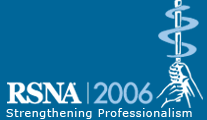
Abstract Archives of the RSNA, 2006
Christina Mueller-Mang MD, Presenter: Nothing to Disclose
Mauricio Castillo MD, Abstract Co-Author: Nothing to Disclose
Thomas Georg Mang MD, Abstract Co-Author: Nothing to Disclose
Fabiola W. Cartes-Zumelzu MD, Abstract Co-Author: Nothing to Disclose
Majda M. Thurnher MD, Abstract Co-Author: Nothing to Disclose
DWI characteristics of fungal brain abscesses are not sufficiently evaluated yet with only a few cases reported in the literature. Our purpose was to investigate: 1) the appearance of fungal cerebral abscesses on DWI, 2) if their imaging characteristics and ADC values were distinct from those of bacterial abscesses, and 3) the utility of DWI and ADC maps/values in distinguishing bacterial from fungal abscesses.
We retrospectively reviewed clinical and MR imaging findings of 9 patients with fungal brain infection due to Aspergillus (n=7), Histoplasma (n=1), and Mucormycosis (n=1), and 16 patients with proven pyogenic brain abscesses. All patients underwent conventional MR sequences and DWI on 1.5T clinical MR scanners. ADC values of 20 fungal and 18 bacterial brain abscesses were calculated and compared by using the Student t test.
Multiple lesions were present in 6/9 patients (67%) with fungal cerebral infection and in 5/15 patients (33%) with bacterial abscesses. Fungal lesions had a mean size of 1.2 ±0.9cm, while the size of bacterial abscesses was 2.6 ±1.6cm. In 3/9 patients with fungal infection the lesions were inhomogeneous on DWI, whereas all bacterial brain abscesses showed homogenous high signal on DWI. All bacterial abscesses showed ring-like enhancement; in 5 patients with fungal infection nodular enhancement was present. Mean ADC value in the fungal group was 0.63±0.22 x10–³mm²/s and 0.47±0.15 x10–³mm²/s in bacterial abscesses. A significant difference between the ADC values of the fungal and the bacterial abscesses was present(P=0.009).
Although imaging characteristics on conventional MRI and DWI are similar for bacterial and fungal brain abscesses, our preliminary data indicate that DWI and ADC measurements may be helpful in distinguishing fungal from bacterial abscesses. Additional findings that support fungal rather than bacterial cerebral infection are multiplicity, heterogeneity and nodular enhancement of lesions.
DWI is a useful imaging modality in the diagnosis of bacterial and fungal brain abscesses and is recommended in the initial evaluation of patients with suspected brain infection.
Mueller-Mang, C,
Castillo, M,
Mang, T,
Cartes-Zumelzu, F,
Thurnher, M,
Fungal versus Bacterial Brain Abscesses: Is Diffusion-weighted MR Imaging Helpful in the Differential Diagnosis?. Radiological Society of North America 2006 Scientific Assembly and Annual Meeting, November 26 - December 1, 2006 ,Chicago IL.
http://archive.rsna.org/2006/4430757.html

